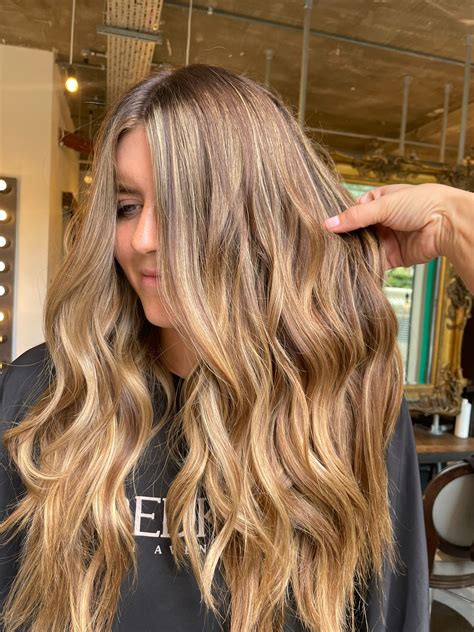Introduction:
Hair coloring techniques like balayage and highlights have become the epitome of chic and stylish hair. Whether you’re craving a subtle touch of color or a bold statement, these methods offer endless possibilities for customization and self-expression. With an estimated global market value of over $75 billion in 2022, it’s clear that the demand for these techniques is unwavering.

Balayage vs. Highlights: Exploring the Differences
Understanding the nuances between balayage and highlights is crucial for making an informed decision about your hair transformation journey. Here’s a comprehensive comparison:
Definition:
-
Balayage: A freehand painting technique where hair color is selectively applied to create a gradual, sun-kissed effect.
-
Highlights: A more traditional method where specific sections of hair are isolated and lightened for a more defined and contrasting look.
Application Technique:
-
Balayage: Hair is typically sectioned and the color is applied in a “sweeping” or “feathering” motion, blending the color seamlessly from root to tip.
-
Highlights: Hair is wrapped in foils or plastic caps, which isolate the sections to be lightened, resulting in more distinct and controlled highlights.
Result:**
-
Balayage: Creates a softer, blended, and more natural-looking effect.
-
Highlights: Produces more defined, contrasting, and striking highlights.
Choosing the Perfect Technique for Your Needs
The best technique for you depends on your desired outcome and hair type. Here are some key factors to consider:
-
Hair Texture: Balayage may be better suited for fine hair, as it doesn’t weigh it down like traditional highlights.
-
Hair Length: Highlights are more appropriate for shorter hair, while balayage works well on longer hair.
-
Maintenance: Balayage requires less maintenance than highlights, as the blended effect grows out more gracefully.
Step-by-Step Guide to Achieving Balayage & Highlights
To embark on your hair transformation journey, follow these detailed steps:
Balayage:
-
Section the Hair: Divide the hair into several sections to ensure even application.
-
Paint the Color: Use a tint brush to apply the hair color in sweeping motions, blending from root to tip.
-
Develop the Color: Allow the color to process for the recommended time, usually around 30-45 minutes.
Highlights:
-
Separate the Hair: Create small sections of hair using the desired technique (e.g., foils or plastic caps).
-
Apply the Bleach: Use a bleach mixture to lighten the isolated hair sections.
-
Tone the Highlights: After processing, apply a toner to ensure a consistent and desired color tone.
Aftercare Tips for Maintaining Your Color
To prolong the vibrancy and health of your colored hair, follow these essential aftercare tips:
-
Use Color-Safe Products: Opt for shampoos, conditioners, and styling products specifically designed for color-treated hair.
-
Limit Heat Styling: Excessive heat can damage the hair and cause color to fade.
-
Protect from Sun Exposure: UV rays can degrade hair color. Use UV-protective hair products or wear a hat when outdoors.
-
Get Regular Trims: Regular trims remove split ends and maintain the desired hair length and shape.
Emerging Trends in Balayage & Highlights
As the hair coloring industry continues to evolve, innovative techniques and trends emerge, pushing the boundaries of hair transformation.
Money Piece:
This face-framing highlight technique involves lightening the hair around the face for a bold and eye-catching effect.
Chunky Highlights:
A modern twist on classic highlights, this trend features thicker, more pronounced sections of lightened hair, creating a bolder and more statement-making look.
Melt Hair:
This technique combines balayage and highlights to create a seamless blend of colors, resulting in a stunning, multi-dimensional effect.
Frequently Asked Questions (FAQs)
Q: Can I do balayage or highlights at home?
A: While it’s possible, it’s highly recommended to seek professional assistance for these techniques to ensure optimal results and minimize hair damage.
Q: How long do balayage and highlights last?
A: With proper care, balayage can last up to 6 months, while highlights may require touch-ups every 8-12 weeks.
Q: Which technique is more damaging to the hair?
A: Highlights involve a stronger bleaching process, making them slightly more damaging to the hair than balayage. However, both techniques can be gentle on the hair when performed by skilled professionals.
Conclusion:
Balayage and highlights offer versatile and customizable hair coloring options, empowering individuals to express their style and transform their appearance. Understanding the differences between these techniques, following the step-by-step guides, adopting proper aftercare practices, and staying abreast of emerging trends ensures a successful hair transformation journey. Embrace these techniques and unleash your inner confidence with a new, beautifully colored hairstyle.
Tables
Table 1: Balayage vs. Highlights
| Feature | Balayage | Highlights |
|---|---|---|
| Application Technique | Freehand painting | Isolation with foils or caps |
| Result | Gradual, sun-kissed effect | Distinct, contrasting highlights |
| Maintenance | Less maintenance | Requires touch-ups every 8-12 weeks |
Table 2: Aftercare Tips for Color-Treated Hair
| Tip | Benefit |
|---|---|
| Use Color-Safe Products | Protects hair color from fading |
| Limit Heat Styling | Prevents hair damage and color loss |
| Protect from Sun Exposure | Shields hair from UV damage |
| Get Regular Trims | Removes split ends and maintains hair health |
Table 3: Emerging Trends in Balayage & Highlights
| Trend | Description |
|---|---|
| Money Piece | Lightened hair around the face |
| Chunky Highlights | Thicker, more pronounced highlights |
| Melt Hair | Seamless blend of balayage and highlights |
Table 4: Estimated Global Market Value of Hair Coloring
| Year | Value (USD) |
|---|---|
| 2022 | $75 billion+ |
| 2028 | Projected $100 billion+ |
